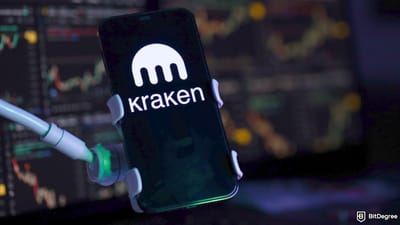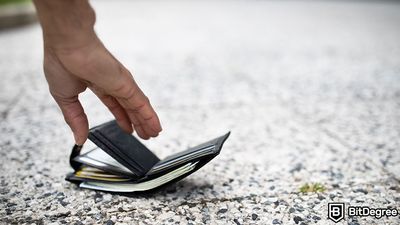Key Takeaways
- While it's tempting to explore methods on how to stake XRP, note that this crypto operates differently as it doesn't use a Proof-of-Stake consensus mechanism like many other digital assets;
- Explore XRP lending or other earning mechanisms as alternatives to staking. These approaches offer the potential to earn interest on your holdings;
- Carefully research where to "stake XRP" as traditional staking isn't applicable. Focus on reputable lending or savings platforms that offer competitive interest rates and robust security measures.
Stop overpaying - start transferring money with Ogvio. Join the waitlist & grab early Rewards NOW! 🎁
You've probably heard the buzz around staking cryptocurrencies for potential rewards. However, when it comes to XRP, things get a bit trickier. Unlike many other digital assets, "XRP staking" doesn't operate on a traditional model.
So, what do you have to do if you want to contribute to the success of this crypto and potentially get rewards? In short, you can lend it instead of "staking XRP" or invest it using various other earning mechanisms. Platforms like Binance offer options for doing this and enabling you to earn interest.
Let's dive deeper into how to make the most of your XRP while understanding the potential risks and rewards.

Did you know?
Subscribe - We publish new crypto explainer videos every week!
What is Litecoin? LTC Easily Explained (ANIMATED)
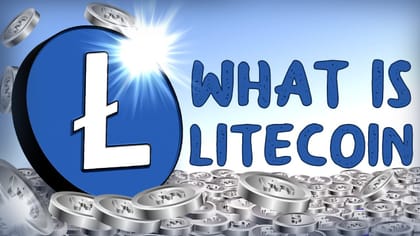

Table of Contents
- 1. What Is XRP Staking?
- 1.1. XRP Staking VS XRP Lending
- 2. Benefits of Lending XRP
- 3. Risks of Lending XRP
- 4. How to Stake XRP (Ripple)?
- 5. How to Earn Interest Using XRP Besides Lending?
- 5.1. Choose a Platform
- 5.2. Create an Account
- 5.3. Buy XRP
- 5.4. Choose the Earning Mechanism
- 6. Best Practices for Earning Interest With XRP
- 7. Conclusions
What Is XRP Staking?
Before we address the question “What is XRP staking?”, let’s uncover what Ripple and XRP are because understanding their fundamental differences is crucial to grasping the concept of staking, or rather, the lack thereof, in the XRP ecosystem.
Latest Deal Active Right Now:Ripple is a technology company that developed a payment network designed for fast and low-cost international transactions. The Ripple network uses a digital asset called XRP to facilitate these transactions, acting as a bridge currency between different fiat currencies. While XRP can improve Ripple's capabilities, it's not mandatory for the network to function.
Essentially, Ripple is the company and the payment network, while XRP is the digital asset that operates within that network.
So, what is XRP staking? Well, let’s define staking first.
Staking is a unique feature of cryptocurrency holding – it’s different from traditional investments like stocks, bonds, or commodities[1]. Investors are typically drawn to staking for two main reasons: earning additional income and influencing the blockchain's decision-making. These motives are often achieved by validating blocks on a Proof-of-Stake (PoS) network.

That’s a common definition of crypto staking, but XRP staking is different because this asset doesn't operate on a Proof-of-Stake consensus mechanism. Instead, the Ripple network uses a Federated Byzantine Agreement (FBA) consensus model to validate transactions.
Unlike Proof-of-Stake (PoS), where anyone can become a validator by staking their cryptocurrency, FBA relies on a pre-selected group of trusted nodes. These nodes, often financial institutions, operate as validators and agree on the order of transactions.
This approach aims to provide speed, security, and finality to transactions while maintaining a certain level of decentralization. Instead of relying on a huge network of anonymous validators, FBA trusts a smaller, known group of participants to maintain the integrity of the network.
In short, can you stake XRP? The answer is no. While XRP doesn't offer traditional staking rewards, there's still a way to generate income from your XRP holdings: lending it out.
XRP Staking VS XRP Lending
Many people confuse XRP staking with XRP lending. While both terms offer the potential for earning returns on your XRP, they represent different strategies. Let's clarify the distinction in the context of XRP.
As I said, XRP doesn’t support staking in the traditional sense because of its consensus mechanism. Some platforms may use the term "XRP staking" to describe other investment products, so it's crucial to understand what's being offered before taking action.

Meanwhile, XRP lending involves providing your XRP to a specific platform. It then lends it to borrowers, and you get interest on your deposited XRP in return. In this case, you’re not involved in verifying transactions or offering security, but you let others borrow your XRP and pay you interest for using it.
When you lend your XRP, it's important to note that lending platforms generally offer different interest rates, loan-to-value ratios, and other terms.
Benefits of Lending XRP
While traditional XRP staking doesn’t exist, you can still get various benefits from lending your XRP.
The most obvious advantage, in my opinion, is getting passive income. Instead of letting your XRP sit idle in a digital wallet, earning nothing or very little, you can put it to work by lending it out. This means you can generate consistent income in the form of interest payments over time.
Additionally, XRP lending often offers more competitive interest rates than traditional savings accounts. The rising popularity of cryptocurrencies may also drive up demand for XRP loans, which in turn can lead to higher returns.
For your information, XRP value has increased drastically since its launch. As of writing, it usually ranges from $0.17 to $0.65, which increases by 282%, with the highest peak at $1.95. I know that we can’t predict the future of cryptocurrencies, but this history highlights the potential for major value appreciation, although you can't stake XRP the common way.
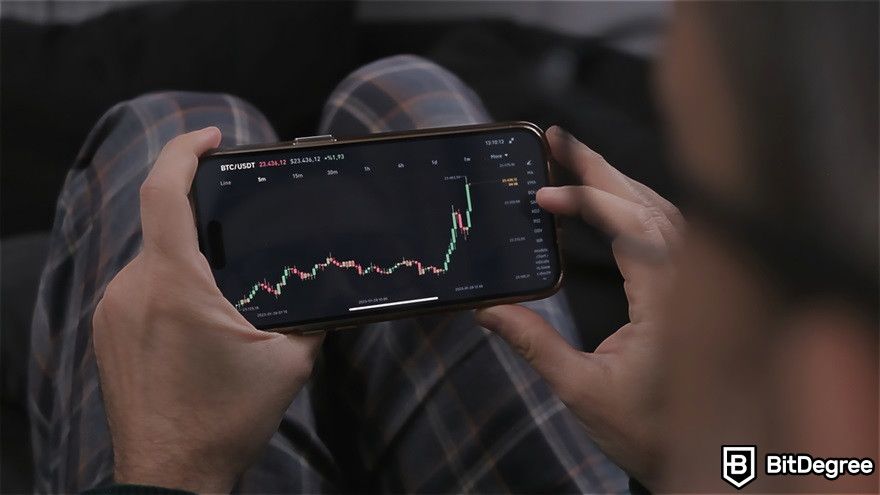
Besides getting interest, some platforms offer the ability to reinvest earned interest, further multiplying the returns on your XRP holdings.
Moreover, lending XRP can be a way to diversify your investment portfolio, spreading risk across different types of assets.
The benefits of XRP staking (well, lending in this case) are also beyond numbers. XRP lenders can also indirectly support the growth of blockchain projects.
These projects often rely on borrowed funds to develop and expand, so, lending your assets means you play a crucial role in driving innovation. This engagement can build a sense of community within the crypto ecosystem, connecting you with like-minded individuals and projects.
Risks of Lending XRP
While XRP staking is unavailable, lending this crypto offers similar rewards to staking other digital assets. Still, it's crucial to understand the potential risks, so you don't end up losing your investment.
One major risk is financial uncertainty. The price of XRP can go up and down, just like other cryptocurrencies, which can affect interest rates on lending platforms and, ultimately, how much money you make.
If the demand for borrowing XRP decreases, this can lead to a big price drop on the market, lower interest rates, and reduced earnings for lenders.
Furthermore, people who borrow your XRP might not pay you back, namely, defaulting on a loan. How likely this is depends on the platform's borrower vetting process and collateral requirements.

Other considerations are related to security and operational risks. Crypto lending platforms may offer products labeled as "XRP staking", which can cause misunderstandings. So, note that these typically involve lending your XRP rather than traditional staking. These platforms can be prone to various risks, including hacking, technical glitches, and smart contract vulnerabilities.
In times of market stress, it may also be difficult to withdraw your XRP from the lending platform, either due to high demand for withdrawals or platform restrictions.
Moreover, if the lending platform itself becomes insolvent or goes bankrupt, lenders may lose their XRP. This risk is particularly relevant for platforms that are not well-established or lack financial stability. Therefore, thorough research on selecting a platform when you learn how to stake XRP is crucial.
How to Stake XRP (Ripple)?
While you can't perform XRP staking, you can earn rewards by lending it. Many cryptocurrency platforms allow users to lend their XRP to others in exchange for interest. This process is often mistakenly referred to as "staking" but is essentially a lending activity.
To become an XRP lender, you need to join a lending platform. Some popular options include Nexo, BlockFi, and Celsius Network. These platforms offer user-friendly interfaces and competitive interest rates.
After signing up, you typically need to deposit your XRP holdings into the platform's wallet. Once your deposit is confirmed, you can start lending your XRP and earning interest.
How to Earn Interest Using XRP Besides Lending?
Besides lending, there are other processes you could refer to as "XRP staking" in the untraditional sense, such as various saving and investing mechanisms. Let's explore these options step by step, from choosing the platform to selecting the best method that suits your financial goals and risk tolerance.
Choose a Platform
Choosing where to "stake XRP" this way is crucial for maximizing your returns and minimizing risks. A reliable platform ensures the security of your assets, offers competitive interest rates, and provides a user-friendly experience.
Well, your chosen platform will be the custodian of your XRP, so selecting a trustworthy and secure one is essential. Here are some key factors to consider:
- Reputation and security. Prioritize platforms with a strong reputation for security and user satisfaction. Look for platforms with positive feedback and a track record of safety measurements. You can find various platform reviews here.
- Interest rates. Compare interest rates offered by different platforms to maximize your returns.
- Fees. Be aware of any fees associated with depositing and withdrawing your XRP. Some platforms charge fees for these actions, while others offer free services. Compare the overall cost of each platform to choose the most cost-effective option.
- Annual percentage rate (APR). It includes the interest rate plus any additional fees associated with the platform. A higher APR means you'll earn more interest on your deposited XRP over a year.
- Supported cryptocurrencies. If you hold other cryptocurrencies, consider platforms that support multiple assets to diversify your portfolio and potentially earn higher overall returns.
- User experience. A user-friendly interface can improve your saving or investing experience. Intuitive navigation, clear information, and easy-to-use features make managing your XRP loans more convenient.
From these criteria, the closest option that matches many of the desired features is Binance. For earning purposes, this platform has Binance Earn, which offers a wide range of cryptocurrencies and competitive interest rates.
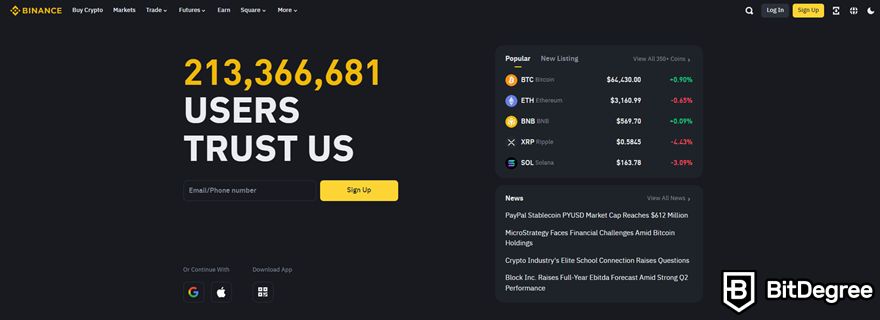
Moreover, it has strong security measures that can protect you from potential risks. For example, Binance has a security fund named Secure Asset Fund for Users (SAFU) that allocates a portion of its trading fees to a secure fund to cover potential losses due to security breaches.
The platform also lets users whitelist specific withdrawal addresses to prevent unauthorized transfers and set two-factor authentication (2FA) to add an extra layer of protection by requiring a second form of verification for login and withdrawals.
Another platform that checks the boxes is Crypto.com.
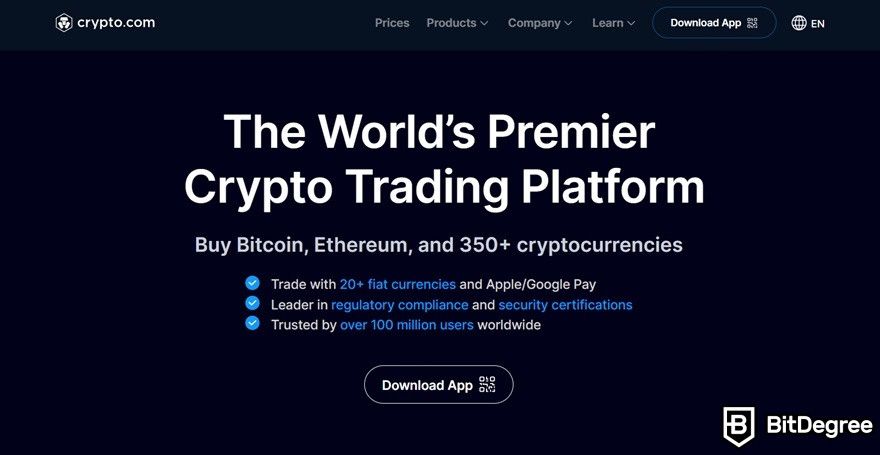
While it may not have the exact same features as Binance, you enjoy its user-friendly interface and competitive interest rates. Plus, it has additional features like a crypto debit card that allows you to spend your crypto directly, which can add more convenience.
This platform also offers other cryptocurrencies to lend, in case you want to diversify your portfolio.
Create an Account
After you decide where to “stake” XRP, it’s time to sign up to the platform and verify your identity. To showcase the process of “XRP staking” in an untraditional sense, I'll use Binance.
However, feel free to explore other platforms that align with your preferences. Just ensure the platform is reputable, secure, easy to navigate, and fits the criteria I mentioned in the previous section.
Step 1: Simply visit the official website and sign up with your email address or phone number. Alternatively, register with your Google account or Apple ID.

Step 2: Verify your identity by completing the know-your-customer (KYC) procedure. Typically, you need to submit your personal details like full name and date of birth and proof of identity such as a passport or driver's license.
Once you've provided the necessary documents, you get a verification email, which usually takes a few business days (or minutes if you use a verified ID and clear photos!).
Buy XRP
Congratulations, your profile has been verified! Now, let's increase your XRP holdings so that you can grow those through Binance Earn. To do this, you can directly purchase the crypto or deposit some funds first before purchasing.
Which method is better? In my opinion, direct purchase is quicker and more convenient, while depositing funds first provides more control over your funds. You can deposit fiat currency into your account and then gradually purchase XRP as needed – suitable for investors who prefer a more hands-on approach to managing their funds.
Direct Purchase
Step 1: Navigate to the "Buy Crypto" page. Input the desired purchase amount in your chosen currency (fiat or stablecoin) on the Spend box and select XRP as the cryptocurrency you want to buy.
Binance automatically calculates the amount of XRP you receive based on the current market price. At the time of wiring, the minimum purchase amount should be $15, so a reminder appears if you enter a lower value.
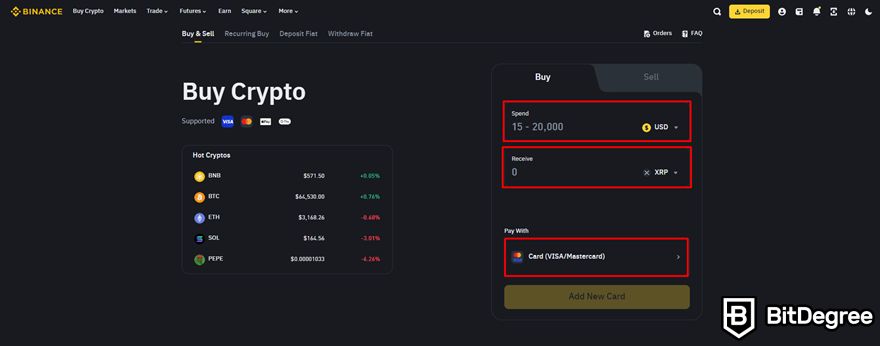
Step 2: Choose your preferred payment method (credit/debit card, Apple Pay, or Google Pay), enter the card information, review the order details, and confirm the transaction. For Apple Pay or Google Pay, you may need to complete additional verification steps.
Depositing Funds First
Step 1: Pick your preferred method: from another account to your Binance account, via credit/debit cards, bank transfers, online payment methods, and peer-to-peer (P2P) trading. To do this, just click the “Deposit” button at the top right of the Binance homepage and select the method you want.
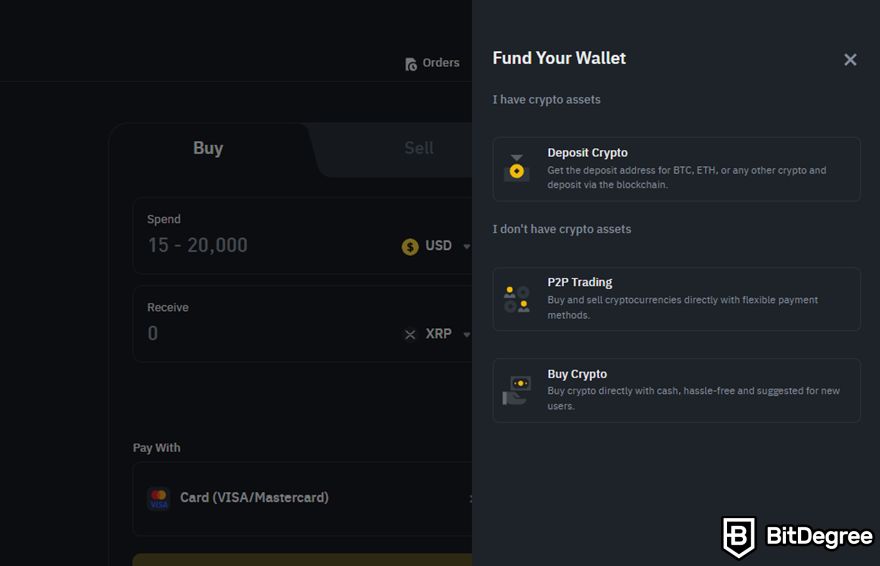
Step 2: Follow the on-screen instructions to complete the transaction. Double-check the address before sending your money because transferring funds to the wrong address can result in permanent loss.
Also, your location can influence the available purchasing or funding options. For example, payment methods like credit cards might be restricted in certain regions. Therefore, check the available payment options based on where you live.

Did you know?
Subscribe - We publish new crypto explainer videos every week!
What is Web3? (Animated Explanation + Examples)



- Secure and reliable
- Accepts fiat currencies
- Lots of trading options
- Reputable exchange
- Accepts fiat currencies
- Offers various trading options

- Huge trading variety
- Regulation-compliant around the globe
- Fair trading fees
- Beginner-friendly
- A wide array of features
- Vast number of different crypto coins & tokens

- Beginner-friendly
- Secure
- Decent trading and withdrawal fees
- Crypto.com Visa Card
- Automated tools & bots
- Ecosystem synergy with CRO
Choose the Earning Mechanism
After you have a verified account and have the token in your wallet, the next step of "XRP staking" on Binance is to choose your desired earning mechanism; there are two ways to “stake” XRP on this platform.
First, you can choose Simple Earn with an estimated APR of 0.76% (at the time of writing). Meaning, you deposit your XRP into the Binance's earning mechanism for a specific period, and in return, you earn APR.
Binance offers a flexible subscription period, so you can decide how long you want to lock up your funds without having to commit to a long-term contract in the first place. This gives freedom to adjust your investment strategy based on market conditions and potentially sell your XRP at any time if needed.
Another option is Dual Investment. This is a Binance feature that allows you to either buy or sell a cryptocurrency at a specific price in the future while earning interest regardless of whether the market goes up or down.

There are two main types of how to "stake" XRP with this method:
- Buy low. Aim to purchase a cryptocurrency at a lower price in the future. If the price drops below your target, you get the cryptocurrency. If the price remains above your target, you recover your initial funds plus interest.
- Sell high. Plan to sell your cryptocurrency at a higher price in the future. If the price surpasses your target, you sell your cryptocurrency. If the price stays below your target, you retain your original cryptocurrency and earn interest.
As of writing this, Dual Investment on Binance offers the APR range of 3.66% to 85.93%, indicating a variable interest rate. This means that the interest you'll earn on your investment can fluctuate between these two percentages, influenced by several factors:
- Market conditions. Changes in cryptocurrency market trends can affect interest rates.
- Platform policies. Binance may adjust rates based on demand and supply.
- Risk assessment. The platform might assess the risk associated with different borrowers and offer varying interest rates accordingly.
It's important to note that the higher end of the range is likely an outlier or a specific product with higher risk. The more typical interest rate for a platform is closer to the lower end of the spectrum.
Also, you need to understand that APR can change due to those factors as well. Therefore, always monitor the APR regularly to stay informed about your potential earnings.
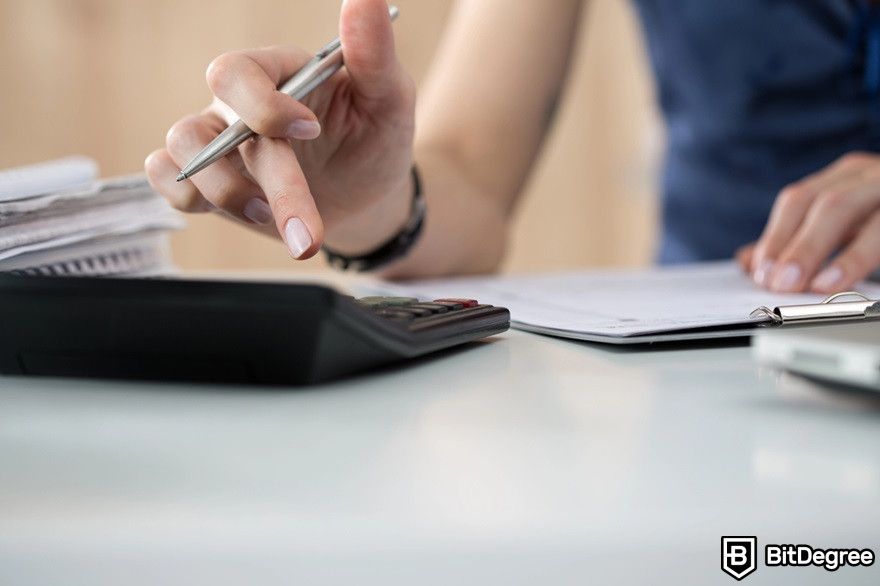
"So, which option should I choose between Simple Earn and Dual Investment?", you might wonder. The best method of "staking" XRP is the one that reflects your risk tolerance and investment goals.
Simple Earn is a lower-risk option for those seeking steady returns, while Dual Investment offers the potential for higher returns but also comes with greater risk.
Proceed with these steps if you choose Simple Earn:
Step 1: Click "Earn" at the top menu and type “XRP” on the provided search bar.
Step 2: Click on the Subscribe button on the "Simple Earn" option.
Step 3: Enter the amount you want to lend, tick the terms and conditions box, and hit the "Confirm" button.
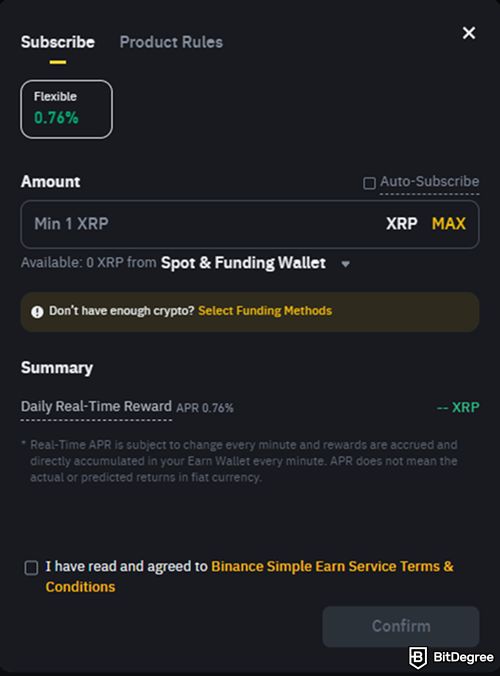
To automate the process (in case you want to stake XRP regularly), I recommend you tick the Auto-Subscribe box. This feature automatically refunds your digital assets into a new Simple Earn term at the end of the lock-in period. Also, consider checking the Product Rules to know the details of your APR rewards and redemption process.
If you choose Dual Investment, you have to pass a quiz provided by Binance and must score a full mark to proceed to the next step. This quiz aims to assess your understanding of the product and associated risks.
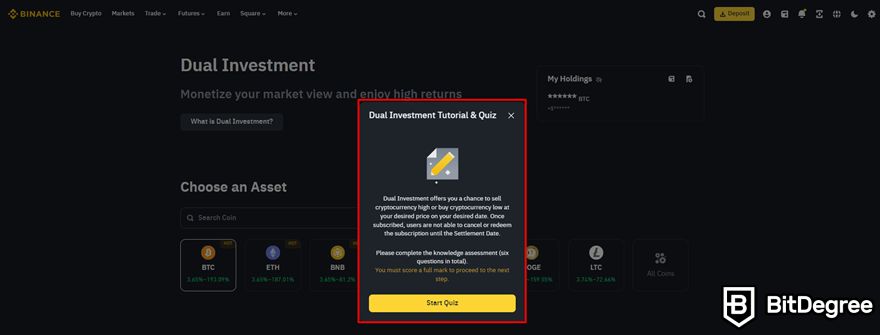
The questions focus on key aspects of Dual Investment, such as the definitions of target price and settlement date. Additionally, you need to solve mathematical problems to test your understanding of potential returns based on different price scenarios.
Best Practices for Earning Interest With XRP
While XRP staking isn't possible due to the network's consensus mechanism, XRP lending or savings offers an alternative to generate potential returns on your holdings. Still, it's essential to follow best practices to maximize returns and minimize risks.
One tip from me is diversifying your assets across multiple platforms to mitigate risk. This aims to reduce the impact of potential losses on a single site. By spreading your XRP investments across exchanges, you can protect yourself from platform-specific risks such as security breaches or financial instability.
Yes, Binance and Crypto.com are reputable. However, the cryptocurrency market is still speculative, and diversification helps safeguard your assets when prices fluctuate wildly[2]. Imagine if one platform faces challenges; spreading your XRP can serve as a safety net. This way, you're not solely reliant on the stability of a single exchange.

Additionally, keep an eye on market conditions and be prepared to adjust your lending or savings strategy in response to changes in the crypto market. This includes monitoring XRP price fluctuations, interest rate trends, and overall sentiment. Be ready to shift your XRP between different platforms or modify your amounts according to what's happening at that time.
If possible, stay in the know about XRP price movements by setting price alerts. Many platforms, including Binance and Crypto.com, allow you to do this, though! These notifications can help you make informed choices for your "XRP staking" strategy, whether it's lending more assets or potentially buying at a dip.
On Binance, activate price alerts on the "Markets" page, click the Settings button, and tick the Price Alert box. You can choose to receive alerts for price reaching a certain level, percentage changes, or both via push notifications on your phone or email.
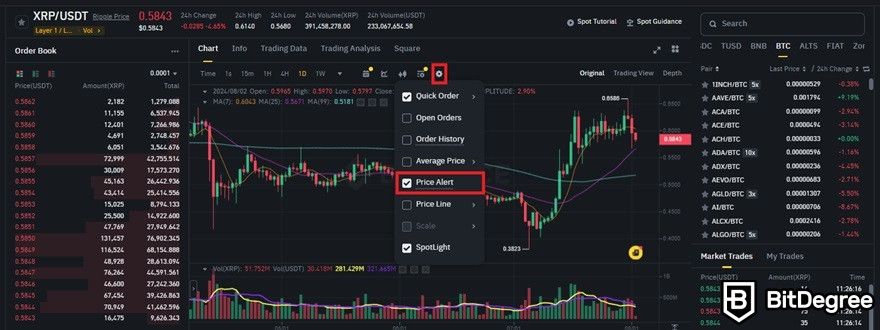
I recommend you set alerts for price drops in XRP. If the price falls below a certain point, you can assess the situation and potentially decide to withdraw your XRP early to minimize losses (It’s possible on Binance, but see if this is allowed by your platform).
Also, set alerts for a desired price target. If the price of XRP rises unexpectedly, you can be notified and consider adjusting the strategy in the future or with your next XRP allocation.
Remember, these alerts are for informational purposes and don't directly impact your XRP lending or savings. However, they can be valuable tools to stay informed about market conditions and potentially refine your overall XRP staking approach.
Are you intrigued by the potential of earning returns on "staking XRP" after checking the market conditions but still unsure about the result? Consider starting small to test the platform and gain experience before committing larger sums. This approach enables you to minimize risk while gradually familiarizing yourself with the process.
Can you “stake XRP” with minimum investment? Well, as of writing, Binance allows users to invest their XRP holdings starting at as little as $15. Although this amount might change over time, this low entry point makes it accessible for beginners to test the waters without risking big capital.
Conclusions
So, can you stake XRP? Well, traditional "XRP staking" isn't a viable option because this crypto relies on a Federated Byzantine Agreement system that doesn't need staked coins to validate transactions.
However, there’s an alternative for potential returns: you can lend XRP or use various other earning mechanisms on platforms like Binance or Crypto.com. Lending or investing XRP enables you to earn interest on your holdings. Binance, for example, lets you do it without a lock-up period for more flexibility in your funding strategy.
Still, do thorough research if you consider "staking XRP" this way. Yes, the benefits are tempting, but understanding the risks involved is important. To manage these risks, consider starting small and gradually increasing your funds as you gain experience.
The content published on this website is not aimed to give any kind of financial, investment, trading, or any other form of advice. BitDegree.org does not endorse or suggest you to buy, sell or hold any kind of cryptocurrency. Before making financial investment decisions, do consult your financial advisor.
Scientific References
1. K. J. Choi, J. Jeon, M. Kwak, et al.: 'Optimal Staking and Liquid Token Holding Decisions in Cryptocurrency Markets';
2. A. Jayawardhana: 'Portfolio Diversification Possibilities of Cryptocurrency: Global Evidence'.


